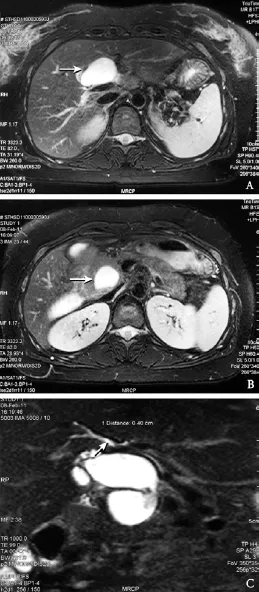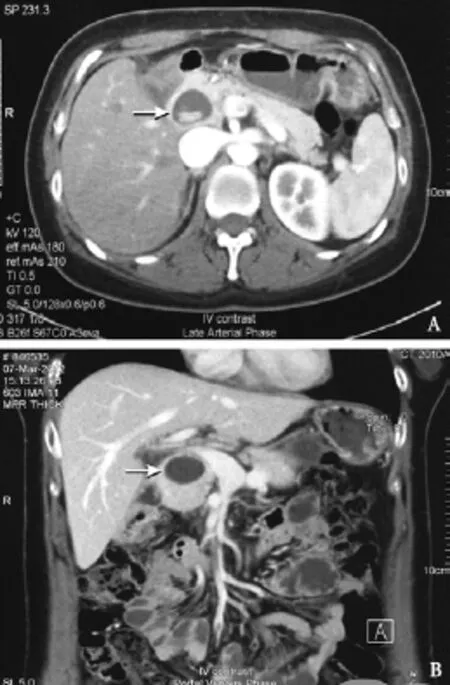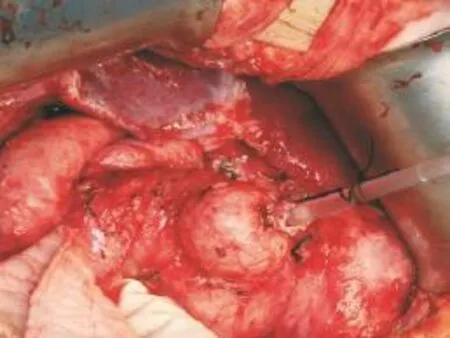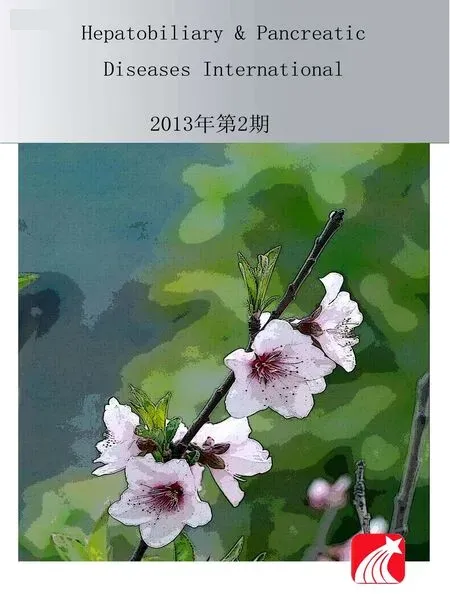Technical note on complete excision of choledochal cysts
Hong Kong, China
Technical note on complete excision of choledochal cysts
Tan To Cheung and Sheung Tat Fan
Hong Kong, China
BACKGROUND:Choledochal cysts are congenital cystic dilatations of the extrahepatic or intrahepatic portion of the biliary tree. Complete excision of choledochal cysts is currently regarded as the gold standard treatment, while less extensive procedures including cystoduodenostomy have become obsolete due to the potential for malignant change in the remnant cyst. For type-1 choledochal cysts, which sometimes extend to the main pancreatic duct closely, some surgeons may adopt a less aggressive approach in order to avoid damage to the main pancreatic duct as such damage can lead to serious consequences. However, incomplete excision of choledochal cysts may also cause problems.
METHOD:Here we report on a reoperation treating incomplete excision of a choledochal cyst with focus on the technical aspect.
RESULTS:In the reoperation, meticulous dissection of the liver hilum which had been previously operated on was performed. The hepaticojejunostomy was left intact. With the assistance of intraoperative cholangiography, the residual pancreatic portion of the choledochal cyst was completely excised. The pancreatic opening and the lower end of the common bile duct were reconstructed. Whipple operation was avoided.
CONCLUSION:Careful planning with the aid of precise imaging before and during the operation largely enhanced the accuracy of the excision of the choledochal cyst.
(Hepatobiliary Pancreat Dis Int 2013;12:218-221)
choledochal cyst; re-excision; incomplete excision
Introduction
Choledochal cysts are a congenital condition commonly found in the young population. The incidence is around 1 in 5000 with a high frequency in Asia.[1,2]The diagnosis is usually made in the fi rst few years of life but many cases are detected in early adulthood. Choledochal cysts are classif i ed according to Todani modif i cation of the Alonso-Lej classif i cation.[3]Type-1 choledochal cysts are the most common presentation, which account for 67.9% of all cases.[4]Apart from Caroli disease (type-5 choledochal cysts) which may require liver transplantation, choledochal cysts are best treated with complete excision, followed by hepaticojejunostomy when technically feasible. It is well recognized that patients with choledochal cysts have a higher risk of cholangiocarcinoma, and cystojejunostomy (or cystoduodenostomy), which was once a popular operation, has become an inferior treatment option in the modern era.[5]Excision of choledochal cysts can be a technically challenging operation, particularly when the lesion is intrahepatic or involves the distal end of the common bile duct. Intrahepatic choledochal cysts may require a partial or an anatomical hepatectomy for complete removal.[6]Lesions involving the pancreas are even more challenging, as injury to the main pancreatic duct may lead to serious complications. Surgeons who do not handle this condition frequently may try to avoid dissection towards the pancreatic duct, but incomplete excision may lead to problematic symptoms posing the risk of malignancy and cause dense adhesion that hinders subsequent operation.
Case report
The patient was a 27-year-old female who presented with epigastric pain. She had no jaundice but her serum alkaline phosphatase level was 540 μmol/L. Magnetic resonance imaging of the liver revealed a type-1 choledochal cyst 3×3.5×7 cm in size involving theproximal bile duct (Fig. 1A) and the pancreatic portion of the distal common bile duct (Fig. 1B). Magnetic resonance cholangiogram showed a tapering of the distal common bile duct making virtually a two-chamber conf i guration of the choledochal cyst (Fig. 1C). Open excision of the choledochal cyst and hepaticojejunostomy were performed in another hospital. She had uneventful recovery and was discharged a week after the operation.
She developed recurrent episodes of epigastric pain, fever, chills and rigors two months after the operation. She was referred to our hospital for further management. Computed tomography showed a 3×3.5×3 cm residual component of choledochal cyst at the distal common bile duct with fi lling defects compatible with stones (Fig. 2A). Reconstruction computed tomography showed that the lesion was mainly inside the head of the pancreas (Fig. 2B). Complete excision of the residual choledochal cyst was indicated due to the symptoms and potential of malignancy.

Fig. 1.A: Magnetic resonance imaging showing the proximal part of the choledochal cyst (arrow);B: Magnetic resonance imaging showing the distal part of the choledochal cyst inside the head of the pancreas (arrow);C: Magnetic resonance cholangiopancreatography showing a narrowing at the middle of the choledochal cyst (arrow).
A right subcostal incision was made along the original wound. Adhesions resulting from the previous operation were taken down. The afferent and efferent limbs of hepaticojejunostomy were identif i ed just anterior to the liver hilum. The porta hepatis was dissected until the stump of the distal common bile duct was identif i ed. The distal component of the choledochal cyst was dissected out from the head of the pancreas until the insertion of the main pancreatic duct was seen. A catheter was inserted into the cyst for operative cholangiography (Fig. 3). Fifteen mL of contrast was instilled into the choledochal cyst and the lower margin of the lesion was shown. Free fl ow of contrast into the duodenum was observed (Fig. 4A). The distal margin of the lesion was marked by Liga clips (Fig. 4B) in order to def i ne the exact site of bile duct resection. The choledochal cyst was removed by cutting at the lowest end of the common bile duct where the main pancreatic duct opening was also exposed (Fig. 5). The common bile duct stump was closed with 5/0 Prolene suture in one single layer and no pancreatic stent was placed across it.

Fig. 2.A: Contrast computed tomography scan showing a residual choledochal cyst in the head of the pancreas with stones inside (arrow);B: Reconstruction computed tomography scan showing the intrapancreatic portion of the choledochal cyst (arrow).

Fig. 3.The choledochal cyst was identif i ed and the intrapancreatic portion was dissected out. A catheter was placed inside the choledochal cyst for cholangiography.

Fig. 4.A: Intraoperative cholangiogram showing the full conf i guration of the choledochal cyst and contrast fl owing freely into the duodenum via the distal portion of the common bile duct;B: Two large metal clips were applied to the lower transection line of the choledochal cyst (arrow).
The patient was kept nil by mouth with total parenteral nutrition support for one week. Somatostatin infusion was administered at 250 mcg per hour in the initial postoperative period to minimize pancreatic secretion.
Histological examination showed cystic dilatation of the common bile duct compatible with choledochal cyst. There was no evidence of malignancy. The patient made an uneventful recovery and did not complain of any recurrent symptoms after the second operation.

Fig. 5.The lower end of the choledochal cyst was cut open, exposing the pancreatic duct opening (arrow).
Discussion
Patients with choledochal cysts can present with jaundice, deranged liver function and cholangitis, which usually lead to early diagnosis in their childhood or even neonatal period.[7]However, the classical triad of presentations is rare and patients may not notice the presence of the disease until their adulthood.
Type-1 choledochal cysts can now be excised with the laparoscopic approach although it is technically demanding.[8,9]The open approach to choledochal cyst excision remains widely practiced although it also requires a lot of expertise. The short-term complication rate for choledochal cyst excision is around 5%. The risk of recurrent cholangitis, pancreatitis, hepaticojejunostomy stricture and intrahepatic stone formation is around 16%.[4,10]The risk of malignancy after complete excision of a choledochal cyst is minimal,[4,11]while the remnant of an incompletely excised choledochal cyst still poses a threat of cancer formation.[12]In the case reported herein, it appeared that the incomplete excision of a type-1 choledochal cyst caused recurrent pancreatitis. However, there was the possibility that a co-existing type-3 choledochal cyst that had been left behind from the fi rst operation presented itself as an intrapancreatic lesion.
In achieving complete excision, preoperative imaging and planning are crucial. Endoscopic retrograde cholangiopancreatography used to be the gold standard for examination of the biliary system, but with the development of modern technology, magnetic resonance cholangiopancreatography can actually provide images of very high quality without posing the risk of complications from instrumentation. In the present case, magnetic resonance cholangiopancreatography nicely demonstrated the presence of narrowing at the middle common bile duct which separated a single lesion into two components. If this was known beforehand, perhaps the lesion could have been completely excised in the fi rst operation.
To achieve complete excision of the lesion in areoperation setting is a more complicated issue. Since the intrapancreatic portion of the lesion was 3 cm, Whipple operation was a backup option during the operation. Meticulous dissection of the liver hilum without destruction of hepaticojejunostomy was possible. The identif i cation of the main portal vein served as an important landmark for searching the truncated common hepatic duct located anteriorly. With the identif i cation of the proximal end of the lesion, operative cholangiography could be performed. It provided the precise anatomy of the operative fi eld, so a clear margin could be achieved. We did not put in a pancreatic stent across the distal common bile duct stump because there was adequate margin for repair. Alternatively, a 4-Fr pancreatic stent could be deployed to reduce the risk of pancreatic fi stula and then be retrieved by endoscopy afterwards. There is a disadvantage of routine placement of pancreatic stent as the stent may sometimes occlude the pancreatic duct, leading to pancreatitis in the early postoperative period. Although the role of somatostatin analogue in pancreatic fi stula formation is controversial, it has been shown that it can effectively decrease the fi stula output and seems to aid fi stula healing.[13-15]
For huge and chronic choledochal cysts, complete excision is not always possible, and pericystic inf l ammation may lead to adhesion of underlying vascular structures including the portal vein. When diff i cult dissection is anticipated, partial excision of the cyst with mucosectomy of the remaining portion can be employed. The outer wall of the remnant cyst can be left adherent to the portal vascular structure without causing symptoms.[16]
Choledochal cyst excision can be a very challenging operation due to the vital structures in the surroundings. Careful planning before operation and the use of operative cholangiography can assure complete excision of the lesions.
Contributors:CTT and FST drafted and revised the manuscript. FST approved the manuscript.
Funding:None.
Ethical approval:Not needed.
Competing interest:No benef i ts in any form have been received or will be received from a commercial party related directly or indirectly to the subject of this article.
1 Kasai M, Asakura Y, Taira Y. Surgical treatment of choledochal cyst. Ann Surg 1970;172:844-851.
2 Howell CG, Templeton JM, Weiner S, Glassman M, Betts JM, Witzleben CL. Antenatal diagnosis and early surgery for choledochal cyst. J Pediatr Surg 1983;18:387-393.
3 Todani T, Watanabe Y, Narusue M, Tabuchi K, Okajima K. Congenital bile duct cysts: Classif i cation, operative procedures, and review of thirty-seven cases including cancer arising from choledochal cyst. Am J Surg 1977;134:263-269.
4 She WH, Chung HY, Lan LC, Wong KK, Saing H, Tam PK. Management of choledochal cyst: 30 years of experience and results in a single center. J Pediatr Surg 2009;44:2307-2311.
5 Yoshikawa K, Yoshida K, Shirai Y, Sato N, Kashima Y, Coutinho DS, et al. A case of carcinoma arising in the intrapancreatic terminal choledochus 12 years after primary excision of a giant choledochal cyst. Am J Gastroenterol 1986; 81:378-384.
6 Todani T, Narusue M, Watanabe Y, Tabuchi K, Okajima K. Management of congenital choledochal cyst with intrahepatic involvement. Ann Surg 1978;187:272-280.
7 Todani T, Urushihara N, Morotomi Y, Watanabe Y, Uemura S, Noda T, et al. Characteristics of choledochal cysts in neonates and early infants. Eur J Pediatr Surg 1995;5:143-145.
8 Liem NT, Dung le A, Son TN. Laparoscopic complete cyst excision and hepaticoduodenostomy for choledochal cyst: early results in 74 cases. J Laparoendosc Adv Surg Tech A 2009;19:S87-90.
9 Tan HL, Shankar KR, Ford WD. Laparoscopic resection of type I choledochal cyst. Surg Endosc 2003;17:1495.
10 Koshinaga T, Hoshino M, Inoue M, Gotoh H, Sugito K, Ikeda T, et al. Pancreatitis complicated with dilated choledochal remnant after congenital choledochal cyst excision. Pediatr Surg Int 2005;21:936-938.
11 Li MJ, Feng JX, Jin QF. Early complications after excision with hepaticoenterostomy for infants and children with choledochal cysts. Hepatobiliary Pancreat Dis Int 2002;1:281-284.
12 Fujisaki S, Akiyama T, Miyake H, Amano S, Tomita R, Fukuzawa M, et al. A case of carcinoma associated with the remained intrapancreatic biliary tract 17 years after the primary excision of a choledochal cyst. Hepatogastroenterology 1999;46:1655-1659.
13 Gans SL, van Westreenen HL, Kiewiet JJ, Rauws EA, Gouma DJ, Boermeester MA. Systematic review and meta-analysis of somatostatin analogues for the treatment of pancreatic fi stula. Br J Surg 2012;99:754-760.
14 Gurusamy KS, Koti R, Fusai G, Davidson BR. Somatostatin analogues for pancreatic surgery. Cochrane Database Syst Rev 2010;CD008370.
15 Gayral F, Campion JP, Regimbeau JM, Blumberg J, Maisonobe P, Topart P, et al. Randomized, placebocontrolled, double-blind study of the eff i cacy of lanreotide 30 mg PR in the treatment of pancreatic and enterocutaneous fi stulae. Ann Surg 2009;250:872-877.
16 Hay SA. Laparoscopic mucosectomy for large choledochal cyst. J Laparoendosc Adv Surg Tech A 2008;18:783-784.
Received June 28, 2012
Accepted after revision August 29, 2012
Announcements for this section should be submitted in the correct format at least 3 months before the required date of publication. This list is provided as a service to readers; inclusion does not imply endorsement by the HBPD INT.
Section editor
Shui-Ying Lei
Email: hbpdje@gmail.com
April, 2013
3rd ELPAT congress on ethical, legal and psychosocial aspects of transplantation
April 20-23, 2013; World Trade Center, Rotterdam, The Netherlands
The main theme of this congress is "Global issue, local solutions" and the focus is on the bridging the divide between international commitments, global outreach and the realization of their potential to improve the lives of patients across the world. The conference is open to all professionals involved in transplant medicine, including, but is not limited to, (bio-)ethicists, philosophers, clinicians, lawyers, anthropologists, psychologists and policy-makers in the fi eld of organ donation and transplantation. For more information, please contact: ELPAT, Frederike Ambagtsheer (Coordinator), or Marian van Noord (Secretary), Erasmus MC - Room D-415, P.O. Box 2040, 3000 CA Rotterdam, The Netherlands. Tel: 31-10-7033002 or 31-6-42668336; Fax: 31-10-4366372; Email: secretariat@elpat.org; Website: www.elpat.org.
May
American transplant congress 2013 May 18-22, 2013; Seattle, WA, USA
The 2013 American transplant congress is the 13th joint annual meeting of the American Society of Transplant Surgeons and the American Society of Transplantation. The American transplant congress will take place on May 18-22, 2013 in Seattle, Washington. The American Transplant Congress is designed for physicians, surgeons, scientists, nurses, organ procurement personnel, and pharmacists who are interested in the clinical and research aspects of solid organ and tissue transplantation. The program is developed to encourage the exchange of new scientif i c and clinical information and support an interchange of opinions regarding care and management issues, as well as socioeconomic, ethical, and regulatory issues relevant to organ and tissue transplantation. American transplant congress, 15000 Commerce Parkway, Suite C, Mt. Laurel, NJ 08054, USA. Tel: 856-439-0880; Fax: 856-439-1972; Website: www.atcmeeting.org.
June
ILTS 19th annual international congress June 12-15, 2013; Sydney, Australia
The 19th annual international congress of ILTS is the leading educational congress for scientists, surgeons, anesthesiologists, physicians, nurses, and organ procurement personnel in the fi eld of liver transplantation from around the world. The congress is designed to allow the liver transplantation specialist to interact and network with individuals from various parts of the globe and to compare and understand the differences in procedures and therapy in the treatment of liver transplantation. Topics include any aspect of liver transplantation including: anesthesia/critical care medicine, extended criteria donors/disease transmission, fulminant liver failure, hepatitis C, immunosuppression, living donor, malignancies, outcomes, patient selection/ organ allocation, pediatrics, radiology, recurrent disease/ pathology, surgical techniques/complications. For more information, please visit: http://2013.ilts.org.
The 1st world congress on controversies in gastroenterology (CIGI)
June 13-15, 2013; Berlin, Germany
The 1st world congress on controversies in gastroenterology (CIGI) will take place in Berlin, Germany on June 13-15, 2013. The intention of the CIGI congress is to function as an exclusive forum for international experts to debate the most important issues in the fi eld of gastroenterology. This thought-provoking academic dialogue will bring to light the most current clinical and technological questions. CIGI aims to provide a forum for discussion, for insights, for recommendations and for reliable solutions. English is the off i cial language of the congress. For more information, please contact: Headquarters & Administration, 53 Rothschild Boulevard, PO Box 68, Tel Aviv, 61000, Israel. Tel: 972-3-5666166; Fax: 972-3-5666177; Email: Info@comtecmed.com. Or Comtec China, Suite 405, Universal Center Building, 175 Xiangyang Road South, Shanghai 200031, China. Tel: 86-21-54660460; Fax: 86-21-54660450; Email: china@ comtecmed.com. Website: http://www.comtecmed.com.
July
22nd annual AACR aspen workshop: molecular biology in clinical oncology
July 21-28, 2013; Westin Snowmass, Snowmass Village, Colorado
The goal of this workshop is to provide a substantive overview of the emerging role that molecular biology plays in the clinical world. Exciting new research on the molecular mechanisms that control cell growth and differentiation has resulted in rapid expansion of our understanding of the fundamental nature of cancer cells and has suggested valuable new approaches to cancer prevention, diagnosis and treatment. The purpose of this workshop is to accelerate this process by increasing the clinical oncologist's awareness and working knowledge of molecular biology concepts and techniques. For further information, please contact Amy Baran, PhD, Program Administrator, at (215) 446-7192 or amy.baran@aacr.org. Website: http://www.aacr.org/home/scientists/meetings--workshops/educational-workshops--special-courses/ molecular-biology-in-clinical-oncology.aspx.
September
Third international conference on frontiers in basic cancer research
September 18-22, 2013; Gaylord National Hotel and Convention Center, National Harbor, MD
Conference chairperson is Prof. Scott W. Lowe from Memorial Sloan-Kettering Cancer Institute, New York, NY, USA. Basic cancer research has been inspired by the study of genes and the processes altered in human cancers by utilizing model systems ranging from yeast to mammals and patient-derived tissue. The third conference in this series will continue in the tradition of providing a stellar broad-based venue for presenting the best in basic cancer research. It is our hope that the meeting will provide a forum for discussion and interaction that will stimulate cross-disciplinary transfer of information, and thereby motivate and strengthen collaborative efforts. The conference will also provide early-career investigators with unique opportunities to interact with the leaders in the fi eld with mentoring roundtables during breakfast and lunch, the opportunity to present short talks in the plenary sessions, and three poster sessions and receptions for scientif i c interaction and networking. The deadline for submission of abstract is July 9, 2013. Website: http://www.aacr.org/home/ scientists/meetings--workshops/frontiers-in-basiccancer-research-.aspx
14th world congress of the International Pancreas and Islet Transplant Association
September 24-27, 2013; Monterey, California, USA
The 14th world congress of the International Pancreas and Islet Transplant Association (IPITA 2013) is to be held in Monterey, California on September 24-27, 2013. The timing of this congress is optimal for the next wave of young scientists, as the meeting symposia will revolve around the multiple evolving options for beta cell replacement. The congress will be held in the spectacular setting of Monterey, strategically located on the Pacif i c Ocean, providing a perfect environment for the exchange of scientif i c ideas. The program will include the following topics: Clinical islet and pancreas transplantation (1, Advances in clinical islet transplantation - is this therapy ready to move beyond "experimental" trials? 2, Technological advances in islet isolation, immunoisolation barriers, beta cell imaging, and organ preservation; 3, Calcineurin-free and other novel immunosuppression regimens following pancreas or islet transplantation; 4, Pancreatectomy and autoislet transplantation for chronic pancreatitis; 5 Pancreas transplantation for indications beyond type 1 diabetes: trauma, pancreatitis, and type 2 diabetes; 6 Strategies to reduce Islet graft attrition); Immunology of islet and pancreas transplantation (1, advances in immunomonitoring the alloimmune and autoimmine response following beta cell replacement; 2, T-regulatory lymphocytes and mixed chimerism as strategies for transplantation tolerance and control of autoimmunity); Alternative source of islets (1, New sources for beta cells -functional maturation of stem cells, animal models, and preclinical issues; 2, Xenotransplantation with porcine islets - status of clinical trials and barriers to widespread application); and Further topics (1, Current state of the technology for insulin delivery and the closed loop; 2, Technological advances in the development of the bioartif i cial pancreas; 3, New advances in islet encapsulation). The deadline for submission of abstract is April 26, 2013. For more information, please contact: Secretariat: c/o: The Transplantation Society, Conference Services, 1255 University Street, Suite 605 Montreal, QC, H3B 3V9, Canada. Tel: 1-514-874-1717; Fax: 1-514-874-1716; Email: info@ipita2013.org; http:// www.ipita2013.org/.
10.1016/S1499-3872(13)60036-3)
AuthorAff i liations:Department of Surgery (Cheung TT and Fan ST) and State Key Laboratory for Liver Research (Fan ST), The University of Hong Kong, Hong Kong, China
Sheung Tat Fan, MD, Department of Surgery, The University of Hong Kong, 102 Pokfulam Road, Hong Kong, China (Tel: 852-22554703; Fax: 852-29865262; Email: stfan@hku.hk)
? 2013, Hepatobiliary Pancreat Dis Int. All rights reserved.
doi: 10.1016/S1499-3872(13)60035-1
 Hepatobiliary & Pancreatic Diseases International2013年2期
Hepatobiliary & Pancreatic Diseases International2013年2期
- Hepatobiliary & Pancreatic Diseases International的其它文章
- Ethyl pyruvate prevents in flammatory factors release and decreases intestinal permeability in rats with D-galactosamine-induced acute liver failure
- Risk factors of choledocholithiasis formation after liver transplantation
- Hepaticojejunostomy with the "Hand-Fan" technique
- Values of circulating GPC-3 mRNA and alpha-fetoprotein in detecting patients with hepatocellular carcinoma
- Management hepatolithiasis with operative choledochoscopic FREDDY laser lithotripsy combined with or without hepatectomy
- Short-term entecavir versus lamivudine therapy for HBeAg-negative patients with acute-onchronic hepatitis B liver failure
